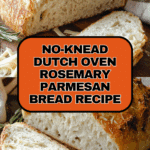Dutch Oven Rosemary Parmesan Bread Recipe
If you are looking for a bread recipe that feels like a warm hug from the oven, you are going to love this Dutch Oven Rosemary Parmesan Bread. It’s a deliciously fragrant, crusty loaf combining the earthy aroma of fresh rosemary with the nutty, savory bite of Parmesan cheese. What makes this bread truly special is how effortlessly it comes together using a simple no-knead method and a trusty Dutch oven that locks in moisture for an irresistible crust. Whether you are a seasoned baker or just starting out, this recipe will become one of your go-to favorites because it is just that comforting and flavorful.

Ingredients You’ll Need
These ingredients are straightforward yet essential to crafting the perfect Dutch Oven Rosemary Parmesan Bread. Each element plays an important role—from the bread flour giving you that chewy texture, to the fresh rosemary and Parmesan providing bursts of flavor that make every slice memorable.
- Bread flour: Provides the structure and chewy crumb that is signature to rustic breads.
- Salt: Enhances all the flavors and balances the richness of cheese and herbs.
- Active dry yeast: Essential for a good rise and that lovely airy interior.
- Lukewarm water: Activates the yeast gently without killing it, key for a good rise.
- Fresh rosemary, finely chopped: Packs an aromatic, piney punch that perfectly complements the Parmesan.
- Fresh Parmesan cheese, grated: Adds a savory, umami richness that melts into the dough as it bakes.
How to Make Dutch Oven Rosemary Parmesan Bread
Step 1: Mix the Dough
Start by combining the bread flour, salt, yeast, chopped rosemary, and Parmesan cheese in a large mixing bowl. Then, add the lukewarm water and stir everything together until you get a shaggy, sticky dough. Don’t worry if it looks a bit sticky—this is the texture you want for a great rise and airy crumb.
Step 2: First Rise
Cover the bowl tightly with plastic wrap and let it sit at room temperature for 12 to 18 hours. This long, slow fermentation is what develops the deep flavor and characteristic texture of this bread. If you want, you can leave it overnight—perfect if you want fresh bread ready the next day.
Step 3: Preheat the Oven
About 45 minutes before baking, preheat your oven to 450°F (230°C). Place your Dutch Oven with its lid inside so it heats up along with the oven. This step is critical for getting that perfect crust when the dough hits the pot.
Step 4: Shape the Dough
After the initial rise, turn the dough out onto a generously floured surface and flour your hands well. Gently shape the dough into a round ball—you want to be gentle to keep all that lovely air trapped, which makes the bread light and fluffy inside.
Step 5: Second Rise
Place a piece of parchment paper on your countertop, transfer the shaped dough onto it, then cover loosely with plastic wrap. Let it rise again for 30 minutes while your oven and Dutch oven are finishing preheating. This step gives your bread that little puff before baking.
Step 6: Bake in the Dutch Oven
Carefully remove the hot Dutch Oven from the oven. Using the parchment paper, lift the dough and place it into the Dutch Oven. Quickly cover with the lid and bake for 30 minutes. The lid traps steam that helps the crust develop a gorgeous, crackly texture.
Step 7: Finish Baking and Cool
Remove the lid and bake for an additional 10 to 15 minutes until the bread turns a beautiful golden brown. When it’s done, transfer your Dutch Oven Rosemary Parmesan Bread to a wire rack and let it cool completely before slicing. This cooling time helps finish the baking process and firms up the crumb.
How to Serve Dutch Oven Rosemary Parmesan Bread

Garnishes
A light drizzle of good olive oil or a sprinkle of flaky sea salt right after baking makes a simple yet irresistible garnish. For a little extra, a spread of herb butter or garlic-infused oil beautifully complements the rosemary and Parmesan flavors.
Side Dishes
This bread pairs wonderfully with hearty soups, stews, or a crisp salad. Think tomato basil soup, creamy butternut squash bisque, or a vibrant mediterranean salad—the fragrant bread is perfect for dipping or creating satisfying bites.
Creative Ways to Present
For a fun twist, slice your Dutch Oven Rosemary Parmesan Bread thick and toast it, then top with smashed avocado and a sprinkle of chili flakes for a flavorful appetizer. You can also use it to build gourmet sandwiches, layering with roasted veggies and cheeses, turning a simple lunch into a celebration.
Make Ahead and Storage
Storing Leftovers
If you have leftover Dutch Oven Rosemary Parmesan Bread, store it in a paper bag or bread box at room temperature up to 2 days to keep the crust crisp and crumb tender. Avoid plastic bags as they trap moisture and can make the crust soggy.
Freezing
To freeze, wrap the cooled bread tightly in plastic wrap and then foil. It can be frozen for up to 3 months. When you’re ready, thaw it at room temperature and refresh in a hot oven for a few minutes to revive that freshly baked texture.
Reheating
To reheat, place the bread in a preheated 350°F (175°C) oven wrapped in foil for 10-15 minutes. Unwrap for the last few minutes to crisp the crust back up. This method brings back that just-baked feeling and flavor—truly delightful.
FAQs
Can I use a different flour instead of bread flour?
Yes, you can substitute all-purpose flour, but bread flour is preferred because it has a higher protein content which helps create a chewier, more elastic crumb. Using all-purpose might result in a slightly softer texture.
Do I have to use fresh rosemary and Parmesan?
Fresh rosemary and freshly grated Parmesan really elevate the flavor. Dried rosemary won’t provide the same aromatic freshness, and pre-grated Parmesan often contains additives that affect melting and flavor. For best results, use fresh ingredients.
Can I skip the second rise?
The second rise improves the bread’s texture and oven spring, but if you’re short on time, you can bake immediately after shaping. Just be prepared for a denser loaf with less volume.
Is a Dutch oven necessary?
The Dutch oven is what creates the ideal steaming environment for crusty bread. If you don’t have one, you can try baking the dough on a baking stone inside the oven with a pan of water to generate steam, but the results might vary.
How long does the bread stay fresh?
Freshly baked Dutch Oven Rosemary Parmesan Bread is best enjoyed within 2 days. Beyond that, it can start to lose its crustiness and freshness, so freezing is a great option if you don’t plan to eat it right away.
Final Thoughts
Making this Dutch Oven Rosemary Parmesan Bread is such a rewarding experience—both the process and the glorious result feel like a gift to yourself and your loved ones. It’s wonderful to share a loaf that smells as good as it tastes, and this recipe is proof that homemade bread can be simple, delicious, and incredibly satisfying. So dust off your Dutch oven, gather those fresh ingredients, and give this recipe a try. Your kitchen will smell incredible, and your friends and family will be asking for seconds in no time!
PrintDutch Oven Rosemary Parmesan Bread Recipe
This Dutch Oven Rosemary Parmesan Bread is a no-knead artisan loaf that combines the fragrant aroma of fresh rosemary with the rich, savory flavor of Parmesan cheese. Baked in a preheated Dutch oven, it develops a crisp, golden crust and a tender, flavorful crumb. Perfect for enjoying as a rustic snack, toasted with butter, or as a gourmet sandwich base, this bread invites you to experience homemade bakery quality right from your kitchen with minimal effort.
- Prep Time: 15 minutes
- Cook Time: 45 minutes
- Total Time: 13 hours (including resting and rising times)
- Yield: 1 loaf (about 8–10 servings) 1x
- Category: Bread
- Method: No-knead baking in Dutch oven
- Cuisine: Italian-inspired Artisan Bread
- Diet: Vegetarian
Ingredients
Dry Ingredients
- 3 cups bread flour
- 1 1/2 teaspoons salt
- 1/2 teaspoon active dry yeast
Wet Ingredients
- 1 1/2 cups lukewarm water
Flavorings
- 1/3 cup fresh rosemary, finely chopped
- 1 cup fresh Parmesan cheese, grated
Instructions
- Mix the Dough: In a large mixing bowl, combine the bread flour, salt, active dry yeast, finely chopped fresh rosemary, and grated Parmesan cheese. Add the lukewarm water and stir until a shaggy and sticky dough forms.
- First Rise: Cover the bowl tightly with plastic wrap and leave it to rest at room temperature for 12 to 18 hours, preferably overnight. This slow fermentation develops complex flavor and a better texture.
- Preheat the Oven: About 30 minutes before baking, preheat your oven to 450°F (230°C). Place your Dutch oven with its lid inside the oven to heat thoroughly.
- Shape the Dough: After the first rise, flour your hands and work surface generously. Gently turn the sticky dough out and shape it into a round loaf ball without kneading aggressively to preserve air bubbles.
- Second Rise: Place a piece of parchment paper on the countertop, transfer the shaped dough onto it, and cover loosely with plastic wrap. Let it rest for 30 minutes while the oven and Dutch oven finish preheating.
- Bake in the Dutch Oven: Carefully remove the hot Dutch oven from the oven, lift the dough using the parchment paper, and place it inside. Cover with the lid and bake for 30 minutes to create steam and develop a crust.
- Finish Baking: Remove the lid and continue baking for 10 to 15 minutes until the bread is deeply golden brown and crusty.
- Cooling: Transfer the baked bread onto a wire rack and let it cool completely before slicing to ensure the crumb sets properly.
Notes
- Ensure the water is lukewarm (about 100°F or 38°C) to activate the yeast effectively without killing it.
- Do not knead the dough extensively; this no-knead method allows the bread to develop a tender crumb with minimal effort.
- The long first rise can be done overnight to fit your schedule conveniently.
- Using a Dutch oven traps steam for a superior crust that mimics professional bakery bread.
- Use fresh rosemary and good quality Parmesan cheese for the best aroma and flavor.
Nutrition
- Serving Size: 1 slice (approx. 60g)
- Calories: 180 kcal
- Sugar: 0.3 g
- Sodium: 350 mg
- Fat: 5 g
- Saturated Fat: 2 g
- Unsaturated Fat: 3 g
- Trans Fat: 0 g
- Carbohydrates: 29 g
- Fiber: 2 g
- Protein: 7 g
- Cholesterol: 10 mg
Keywords: Rosemary bread, Parmesan bread, no-knead bread, Dutch oven bread, artisan bread, homemade bread, no-knead rosemary parmesan bread








